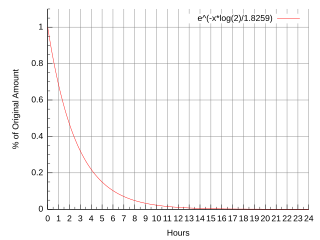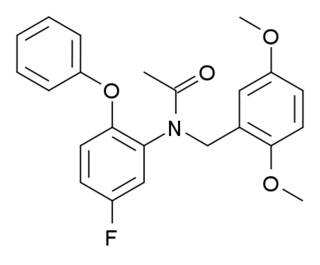Related Research Articles

Positron emission tomography (PET) is a functional imaging technique that uses radioactive substances known as radiotracers to visualize and measure changes in metabolic processes, and in other physiological activities including blood flow, regional chemical composition, and absorption. Different tracers are used for various imaging purposes, depending on the target process within the body. For example, 18
F
-FDG is commonly used to detect cancer, NaF18
F
is widely used for detecting bone formation, and oxygen-15 is sometimes used to measure blood flow.

Single-photon emission computed tomography is a nuclear medicine tomographic imaging technique using gamma rays. It is very similar to conventional nuclear medicine planar imaging using a gamma camera, but is able to provide true 3D information. This information is typically presented as cross-sectional slices through the patient, but can be freely reformatted or manipulated as required.

Karl Barry Sharpless is an American chemist and a two-time Nobel laureate in Chemistry known for his work on stereoselective reactions and click chemistry.
A radioactive tracer, radiotracer, or radioactive label is a chemical compound in which one or more atoms have been replaced by a radionuclide so by virtue of its radioactive decay it can be used to explore the mechanism of chemical reactions by tracing the path that the radioisotope follows from reactants to products. Radiolabeling or radiotracing is thus the radioactive form of isotopic labeling. In biological contexts, use of radioisotope tracers are sometimes called radioisotope feeding experiments.
Pittsburgh compound B (PiB) is a radioactive analog of thioflavin T, which can be used in positron emission tomography scans to image beta-amyloid plaques in neuronal tissue. Due to this property, Pittsburgh compound B may be used in investigational studies of Alzheimer's disease.

[18F]Fluorodeoxyglucose (INN), or fluorodeoxyglucose F 18, also commonly called fluorodeoxyglucose and abbreviated [18F]FDG, 2-[18F]FDG or FDG, is a radiopharmaceutical, specifically a radiotracer, used in the medical imaging modality positron emission tomography (PET). Chemically, it is 2-deoxy-2-[18F]fluoro-D-glucose, a glucose analog, with the positron-emitting radionuclide fluorine-18 substituted for the normal hydroxyl group at the C-2 position in the glucose molecule.

Fluorine-18 (18F) is a fluorine radioisotope which is an important source of positrons. It has a mass of 18.0009380(6) u and its half-life is 109.771(20) minutes. It decays by positron emission 96% of the time and electron capture 4% of the time. Both modes of decay yield stable oxygen-18.

Chronic traumatic encephalopathy (CTE) is a neurodegenerative disease linked to repeated trauma to the head. The encephalopathy symptoms can include behavioral problems, mood problems, and problems with thinking. The disease often gets worse over time and can result in dementia.
Michael Edward Phelps is a professor and an American biophysicist. He is known for being one of the fathers of positron emission tomography (PET).

DAA-1106 is a drug which acts as a potent and selective agonist at the peripheral benzodiazepine receptor, also known as the mitochondrial 18 kDa translocator protein or TSPO, but with no affinity at the GABAA receptor. It has anxiolytic effects in animal studies. DAA-1106 has a sub-nanomolar binding affinity (Ki) of 0.28nM, and has been used extensively in its 3H or 11C radiolabelled form to map TSPO in the body and brain, which has proved especially helpful in monitoring the progress of neurodegenerative diseases such as Alzheimer's disease.
Avid Radiopharmaceuticals is an American company, founded by Dr. Daniel Skovronsky, and based at the University City Science Center research campus in Philadelphia, Pennsylvania. The company has developed a radioactive tracer called florbetapir (18F). Florbetapir can be used to detect beta amyloid plaques in patients with memory problems using positron emission tomography (PET) scans, making the company the first to bring to market an FDA-approved method that can directly detect this hallmark pathology of Alzheimer's disease.

Brain positron emission tomography is a form of positron emission tomography (PET) that is used to measure brain metabolism and the distribution of exogenous radiolabeled chemical agents throughout the brain. PET measures emissions from radioactively labeled metabolically active chemicals that have been injected into the bloodstream. The emission data from brain PET are computer-processed to produce multi-dimensional images of the distribution of the chemicals throughout the brain.
Florbetaben, a fluorine-18 (18F)-labeled stilbene derivative, trade name NeuraCeq, is a diagnostic radiotracer developed for routine clinical application to visualize β-amyloid plaques in the brain. It is indicated for Positron Emission Tomography (PET) imaging of β-amyloid neuritic plaque density in the brains of adult patients with cognitive impairment who are being evaluated for Alzheimer's disease (AD) and other causes of cognitive impairment. β-amyloid is a key neuropathological hallmark of AD, so markers of β-amyloid plaque accumulation in the brain are useful in distinguishing AD from other causes of dementia. The tracer successfully completed a global multicenter phase 0–III development program and obtained approval in Europe, US and South Korea in 2014.
Primary age-related tauopathy (PART) is a neuropathological designation introduced in 2014 to describe the neurofibrillary tangles (NFT) that are commonly observed in the brains of normally aged and cognitively impaired individuals that can occur independently of the amyloid plaques of Alzheimer's disease (AD). The term and diagnostic criteria for PART were developed by a large group of neuropathologists, spearheaded by Drs. John F. Crary and Peter T. Nelson. Despite some controversy, the term PART has been widely adopted, with the consensus criteria cited over 1130 times as of April 2023 according to Google Scholar.

Fluciclovine (18F), also known as anti-1-amino-3-18F-fluorocyclobutane-1-carboxylic acid, or as Axumin, is a diagnostic agent indicated for positron emission tomography (PET) imaging in men with suspected prostate cancer recurrence based on elevated prostate specific antigen (PSA) levels.

Carbon-11 choline is the basis of medical imaging technologies. Because of its involvement in biologic processes, choline is related to diseases, leading to the development of medical imaging techniques to monitor its concentration. When radiolabeled with 11CH3, choline is a useful a tracer in PET imaging. Carbon-11 is radioactive with a half-life of 20.38 minutes. By monitoring the gamma radiation resulting from the decay of carbon-11, the uptake, distribution, and retention of carbon-11 choline can be monitored.

Flortaucipir (18F), sold under the brand name Tauvid, is a radioactive diagnostic agent indicated for use with positron emission tomography (PET) imaging to image the brain.

Julie C. Price is an American medical physicist and professor of radiology at Massachusetts General Hospital (MGH), Harvard Medical School (HMS), as well as the director of PET Pharmacokinetic Modeling at the Athinoula A. Martinos Center at MGH. Price is a leader in the study and application of quantitative positron emission tomography (PET) methods. Prior to this, Price worked with Pittsburgh colleagues to lead the first fully quantitative pharmacokinetic evaluations of 11C-labeled Pittsburgh compound-B (PIB), one of the most widely used PET ligands for imaging amyloid beta plaques. As a principal investigator at MGH, Price continues work to validate novel PET methods for imaging biological markers of health and disease in studies of aging and neurodegeneration, including studies of glucose metabolism, protein expression, neurotransmitter system function, and tau and amyloid beta plaque burden.
M. G. Finn is an American chemist and professor at the Georgia Institute of Technology.
Alzheimer's disease (AD) in African Americans is becoming a rising topic of interest in AD care, support, and scientific research, as African Americans are disproportionately affected by AD. Recent research on AD has shown that there are clear disparities in the disease among racial groups, with higher prevalence and incidence in African Americans than the overall average. Pathologies for Alzheimer’s also seem to manifest differently in African Americans, including with neuroinflammation markers, cognitive decline, and biomarkers. Although there are genetic risk factors for Alzheimer’s, these account for few cases in all racial groups.
References
- 1 2 Kolb, Hartmuth C.; Finn, M. G.; Sharpless, K. Barry (June 1, 2001). "Click Chemistry: Diverse Chemical Function from a Few Good Reactions". Angewandte Chemie . 40 (11): 2004–2021. doi: 10.1002/1521-3773(20010601)40:11<2004::AID-ANIE2004>3.0.CO;2-5 . ISSN 1521-3773. PMID 11433435.
- ↑ "Lexicon Genetics to Acquire Coelacanth Corporation | Lexicon Pharmaceuticals, Inc". www.lexpharma.com. Retrieved 2022-10-08.
- ↑ "TAUVID™ (flortaucipir F 18 injection), for intravenous use. Initial U.S. Approval: 2020" (PDF).
- ↑ Finn, M. G.; Kolb, Hartmuth C.; Sharpless, K. Barry (2022-01-12). "Click chemistry connections for functional discovery". Nature Synthesis . 1 (1): 8–10. Bibcode:2022NatSy...1....8F. doi: 10.1038/s44160-021-00017-w . ISSN 2731-0582. S2CID 245916585.
- ↑ "Scientific Background on the Nobel Prize in Chemistry 2022" (PDF).
- ↑ Xia, Chun‐Fang; Arteaga, Janna; Chen, Gang; Gangadharmath, Umesh; Gomez, Luis F.; Kasi, Dhanalakshmi; Lam, Chung; Liang, Qianwa; Liu, Changhui; Mocharla, Vani P.; Mu, Fanrong; Sinha, Anjana; Su, Helen; Szardenings, A. Katrin; Walsh, Joseph C. (November 2013). "[ 18 F]T807, a novel tau positron emission tomography imaging agent for Alzheimer's disease". Alzheimer's & Dementia. 9 (6): 666–676. doi:10.1016/j.jalz.2012.11.008. ISSN 1552-5260. PMID 23411393. S2CID 1079628.
- ↑ Chien, David T.; Bahri, Shadfar; Szardenings, A. Katrin; Walsh, Joseph C.; Mu, Fanrong; Su, Min-Ying; Shankle, William R.; Elizarov, Arkadij; Kolb, Hartmuth C. (2013-06-20). "Early Clinical PET Imaging Results with the Novel PHF-Tau Radioligand [F-18]-T807". Journal of Alzheimer's Disease. 34 (2): 457–468. doi:10.3233/JAD-122059. PMID 23234879. S2CID 46044539.
- ↑ Triana‐Baltzer, Gallen; Moughadam, Setareh; Slemmon, Randy; Van Kolen, Kristof; Theunis, Clara; Mercken, Marc; Kolb, Hartmuth C. (January 2021). "Development and validation of a high‐sensitivity assay for measuring p217+tau in plasma". Alzheimer's & Dementia: Diagnosis, Assessment & Disease Monitoring. 13 (1): e12204. doi:10.1002/dad2.12204. ISSN 2352-8729. PMC 8158165 . PMID 34095436.
- ↑ "Hartmuth Kolb, PhD, Wins 2015 Alzheimer Award". IOS Press . June 26, 2015.
- ↑ "Multidimensional Click Chemistry | 2021 Organic Division Horizon Prize: Robert Robinson Award in Synthetic Organic Chemistry winner". Royal Society of Chemistry. Retrieved 2022-10-08.